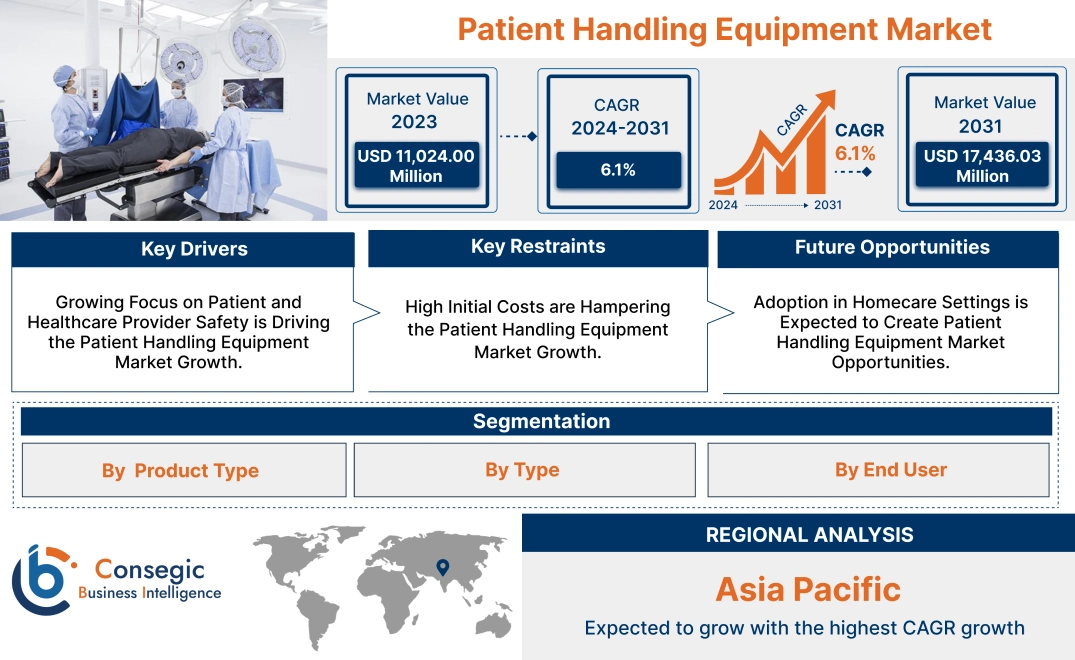Patient Handling Equipment Market Size:
The Patient Handling Equipment Market size is estimated to reach over USD 17,705.34 Million by 2032 from a value of USD 11,396.79 Million in 2024 and is projected to grow by USD 11,843.73 Million in 2025, growing at a CAGR of 6.10% from 2025 to 2032.
Patient Handling Equipment Market Scope & Overview:
Patient handling equipment refers to facilities that ensure the safe transfer and transportation of patients. This equipment encompasses a wide range of products, such as patient lifts, transfer boards and aids, gait belts, wheelchairs, and safety devices, among others. Moreover, these devices are categorized as mechanical and non-mechanical, based on their properties and uses. They serve acute care, critical care, and long-term care settings. These types of equipment are important for ensuring the safety of both patients and healthcare providers, thereby reducing the risk of injuries during medical procedures and daily care activities. Due to its wide range of applications, this equipment plays a vital role in hospitals, ambulatory surgical centers, rehabilitation centers, and home care settings, facilitating patients' mobility.
Patient Handling Equipment Market Dynamics - (DRO) :
Key Drivers:
The Rise of the Aging Population and Increasing Chronic Disease Prevalence Globally is Fueling the Demand for the Patient Handling Equipment Market.
With age, the health condition starts deteriorating, leading to less mobility. This happens due to several factors, such as weak muscles and bones, and stiffened joints, which significantly cause tiredness and difficulty in moving. Due to this, there is a growing demand for these types of equipment, such as wheelchairs and patient lifts. Moreover, people diagnosed with chronic diseases, including cancer, diabetes, and other long-lasting health conditions, require these equipment to improve their mobility and foster easy body movements.
- For instance, Florida Atlantic University recently developed a Portable Patient Lift called the UPLIFT. It is designed to address the limitations of the traditional patient lifts, which are often bulky and difficult to handle. Its features include a semi-collapsible lifting device facilitating the safe transfer of patients up to 300 pounds. Moreover, it integrates a telescoping mast driven by linear actuators along with a lifting arm for secure patient handling. This innovation enhances the mobility of patients, ensuring their safe transfer.
As the demand for these equipment is rising, innovations in the healthcare sector continue to grow significantly.
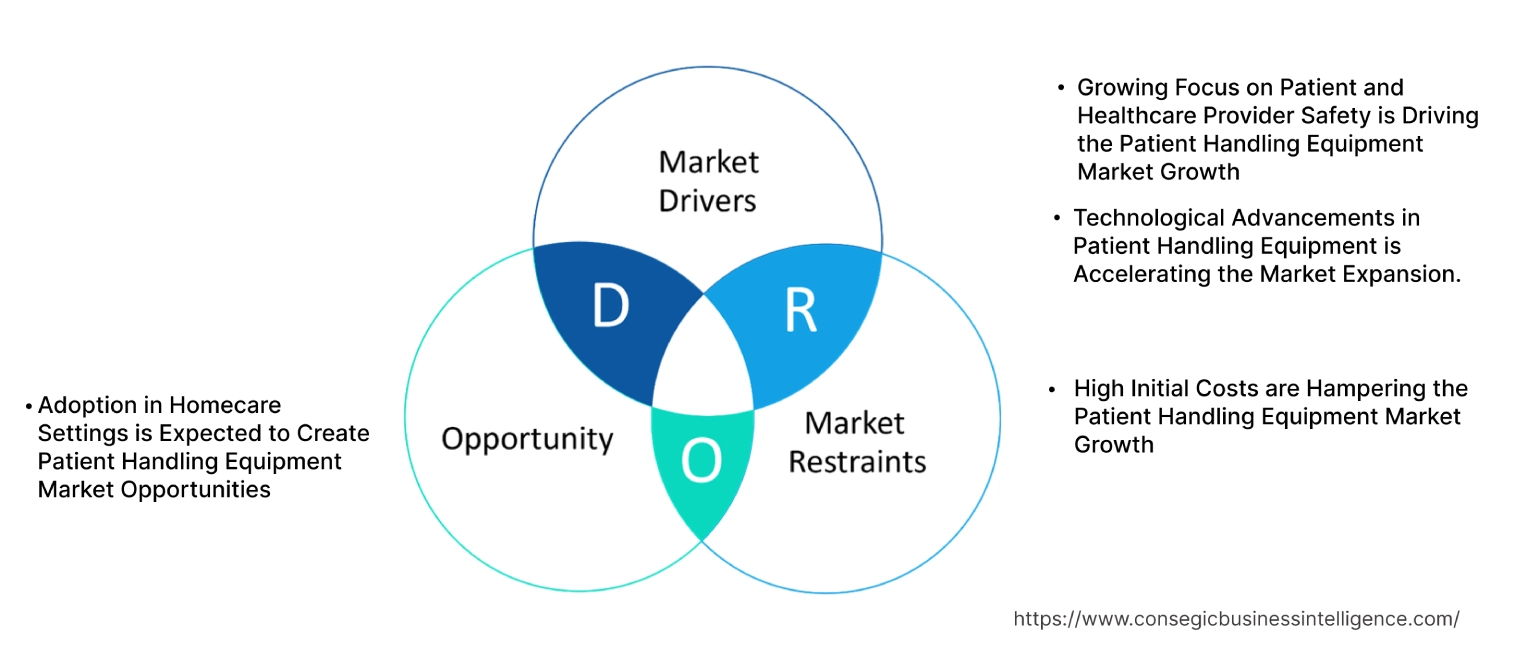
Key Restraints :
High Upfront Costs of the Patient Handling Equipments are Restricting its Market Growth.
With innovations in the patient handling equipment industry, the cost of these instruments is also rising, creating a hurdle for healthcare facilities, limiting the market growth. Additionally, in case of any faults in the equipment, it can lead to higher expenses, which is a major factor that restrains healthcare facilities from purchasing it.
With high initial and maintenance costs, along with the expenses of training the healthcare workers, it constrains the hospitals from buying this equipment, thus hampering the patient handling equipment market growth.
Future Opportunities :
Integration of AI And IoT Opens New Avenues for the Market
The integration of advanced technologies such as artificial intelligence and Internet of Things in these instruments will enable real-time monitoring of the patient’s location, automatic adjustment of the equipment as per the patient's requirements, along with embedded voice assistants to make it easy for the patient as well as the care provider to use the instrument easily and efficiently.
- For instance, in April 2025, a robotic patient transfer device was launched in Canada at the Ottawa Hospital. A robot was designed to transfer patients in and out of the hospital beds using a button. Transferring patients manually can be tiring at times. Using this technology ensures easy and safe handling of patients, thus reducing the risk of mishaps.
Use of advanced technology in patient handling equipment will revolutionize the healthcare industry, thereby presenting opportunities to the market.
Patient Handling Equipment Market Segmental Analysis :
By Equipment Type:
Based on equipment type, the market is segmented into medical beds, patient transfer devices, and patient transportation devices.
Trends in the Equipment Type:
- The key trends in the equipment for patient handling include the integration of advanced technologies such as artificial intelligence, Internet of Things, robotics, and ergonomics.
- AI and IoT are used for real-time patient monitoring and automatic adjustment of the equipment is one of the rising trends.
The medical beds segment accounted for the largest revenue of the overall patient handling equipment market share in 2024.
- Medical beds are special beds in healthcare facilities that are designed to provide optimal comfort to patients.
- They incorporate features such as adjustable height, pressure relief surfaces, integrated positioning systems, side rails, and built-in scales. These features help to enhance patient well-being.
- The growing population and the increasing prevalence of chronic illnesses, such as diabetes, are driving the requirement for medical beds.
- As per the patient handling equipment market analysis, advancements in technology, such as smart beds with built-in sensors using IoT and remote monitoring of patients, have fostered quicker responses to emergencies along with proper care.
The patient transfer devices segment is expected to grow at the fastest CAGR over the forecast period.
- Patient transfer devices refer to the equipment that enables the mobility of patients. These devices include patient lifts, wheelchairs, and others.
- The need for these devices is growing rapidly due to more emphasis on patient comfort. Individuals who are finding it difficult to move due to injuries or old age use these devices to move with ease.
- Additionally, these devices make it easier for healthcare providers to help patients with their movements.
- Unlike the manual method of transferring patients, the advanced transfer devices have proved to make a significant difference in patient care and ease of use.
By End User:
Based on the End User the market is segmented into hospitals, healthcare centers, clinics, homecare settings, and others.
Trends in the End User:
- There is a growing trend for patient-centered care facilities for enhancing the patient recovery rate in hospitals and healthcare settings.
- Another major trend is hospitals utilizing advanced equipment to ensure proper treatment is being provided to their patients.
The hospitals segment accounted for the largest revenue market share of 42.18% in 2024.
- Hospitals require a wide range of equipment, including patient lifts, wheelchairs, gait belts, and other devices to safely move and position patients.
- The increasing number of elderly patients and the growing emphasis on patient safety and staff well-being are driving the requirement for advanced equipment for patient handling in hospitals.
- Additionally, the growing trend toward patient-centered care is increasing the demand for comfortable and efficient patient handling devices in hospitals.
- With the realization of the risks associated with manual patient handling, there has been a significant shift towards smart equipment for patient handling.
- By providing proper equipment and training to the staff on their safe and effective use, healthcare organizations significantly reduce the incidence of injuries while operating the equipment and provide medical assistance.
- Thus, as per the analysis, with the increase in demand for proper treatment and healthcare facilities, hospitals dominate in the overall patient handling equipment market.
The homecare settings segment is expected to grow at the fastest CAGR during the forecast period.
- Home care is the provision of medical treatment and care by professionals to individuals in their residences. This type of care is designed to help people who are aging, disabled, chronically ill, or recovering from a medical event to improve their quality of life while receiving healthcare services.
- As these individuals opt for home-based care, the requirement for equipment used for patient handling in-home use is growing.
- Devices such as wheelchairs, walking aids, transfer aids, lifting slings, and bath hoists help caregivers safely and efficiently manage patients at home.
- In addition, the rise in home care services is boosting the requirement for patient-handling devices. Demographic shifts, such as the aging population and rising prevalence of chronic diseases, significantly fuel the patient handling equipment market expansion.
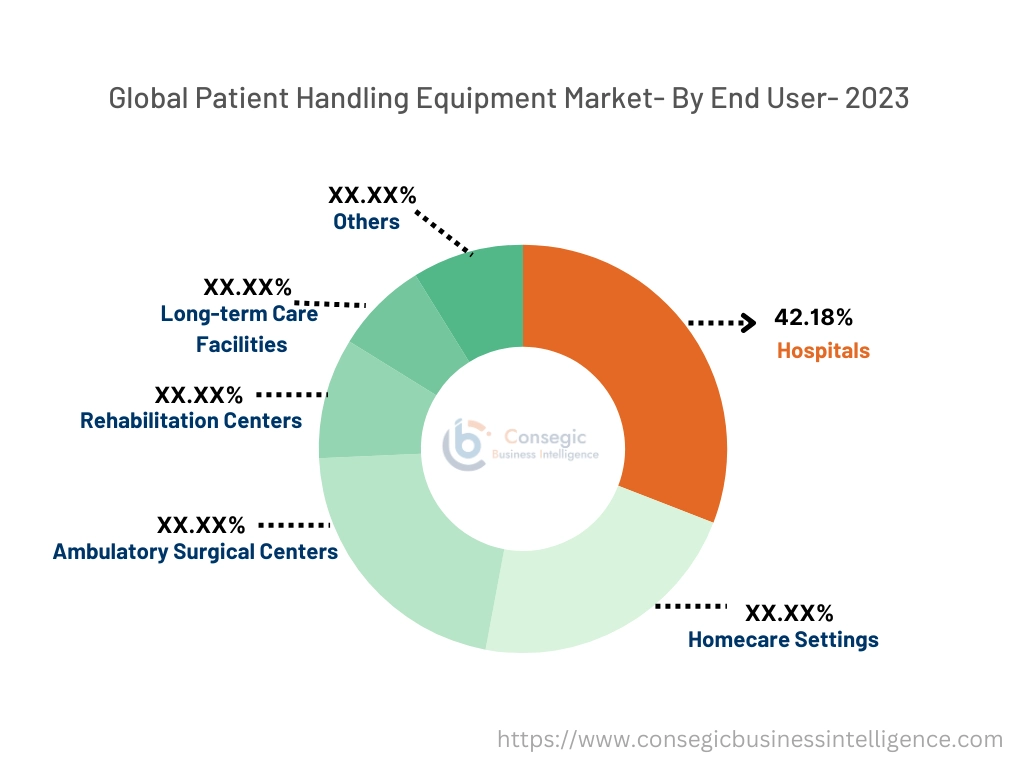
By Application:
Based on the application the market is segmented into acute care, critical care, bariatric care, long-term care, and others.
Trends in the Application:
- The patient handling equipment market trends include the increase in demand for home care services for easy transportation of patients.
- Moreover, there is a growing trend towards ergonomic designs in the patient handling equipment market for reducing the risk of musculoskeletal injuries.
The acute care segment accounted for the largest market share in the year 2024.
- Acute care can be defined as short-term healthcare services provided to the patient based on the severity of the patient's condition. These include surgery, critical care, trauma care, and emergency care.
- The services include Intensive Care Unit (ICU), Coronary Care Unit (CCU), and Neonatal Intensive Care Unit (NICU).
- Acute care is needed for patients who are suffering from trauma due to a severe accident or critical conditions.
- For instance, Ceiba Healthcare, in August 2022, expanded its tele-ICU platform in Germany, providing real-time information about patients' needs and emergencies through snapshots of all ICU patients.
- According to patient handling equipment market analysis, the acute care segment currently dominates the market due to its increasing need for advanced facilities to enhance patient care, leading to market expansion.
The Bariatric Care segment is expected to grow at the fastest CAGR during the forecast period.
- The increasing rate of obesity among individuals has led to the growing need for patient handling equipment to assist with easy mobility for them.
- Moreover, with the rise in the aging population and unhealthy lifestyle choices, individuals struggle with movement due to obesity, fueling the need for bariatric care.
- Healthcare facilities, such as hospitals, are integrating bariatric-specific equipment to enhance patient comfort and facilitate proper care, leading to its faster growth in the market.
Regional Analysis:
The regional segment includes North America, Europe, Asia Pacific, the Middle East and Africa, and Latin America.
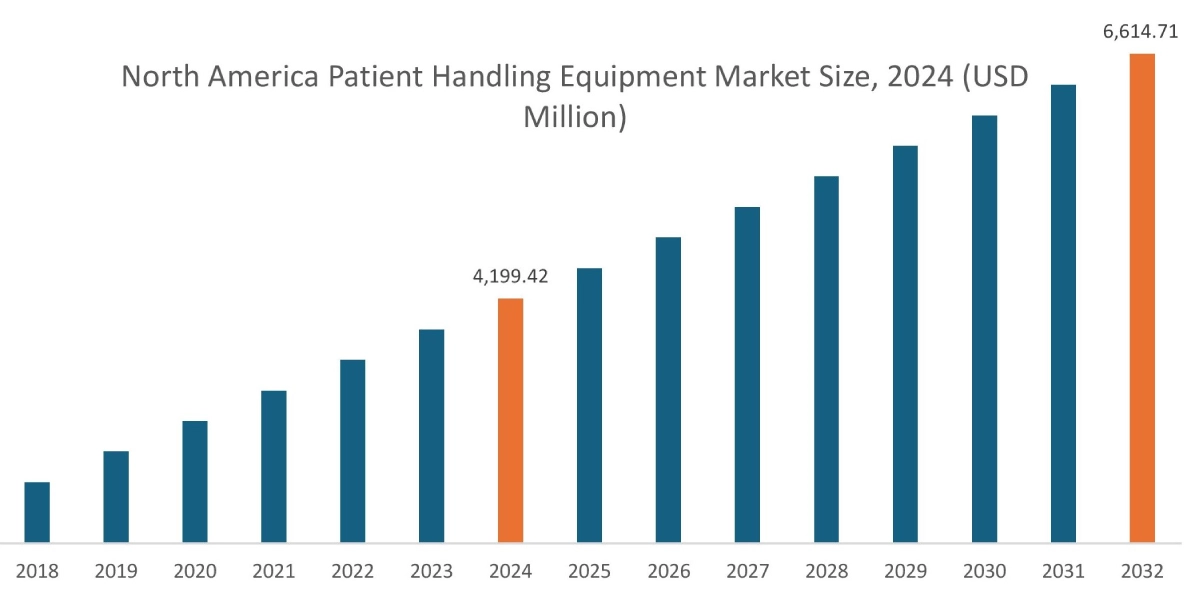
In 2024, North America accounted for the highest market share of 36.8%, valued at USD 4,199.42 million, and is expected to reach USD 6,614.71 million in 2032. In North America, the U.S. accounted for the highest share of 68.20% in the year 2024.
The North American region is the largest market for patient handling equipment, driven by factors such as the increasing prevalence of chronic diseases, an aging population, and stringent regulations for patient safety and worker well-being. The United States is a major market focusing on technological advancements and innovative product development. Government bodies across the region are implementing initiatives to improve patient and healthcare provider safety.
- For instance, in October 2024, Joerns Healthcare announced sale of its UK-based Oxford patient handling equipment business to Prism Healthcare. It represented the company’s strategy to align its focus toward key North American Markets.
Additionally, the region's healthcare infrastructure, coupled with a growing emphasis on patient-centered care, has led to a significant requirement for advanced equipment. By reducing the risk of injuries and improving efficiency, these devices prove to be useful and safe for the patients as well as the healthcare providers. Thus, as per the analysis, a combination of the aforementioned factors and trends is driving the substantial rise in the North American patient handling equipment market share.
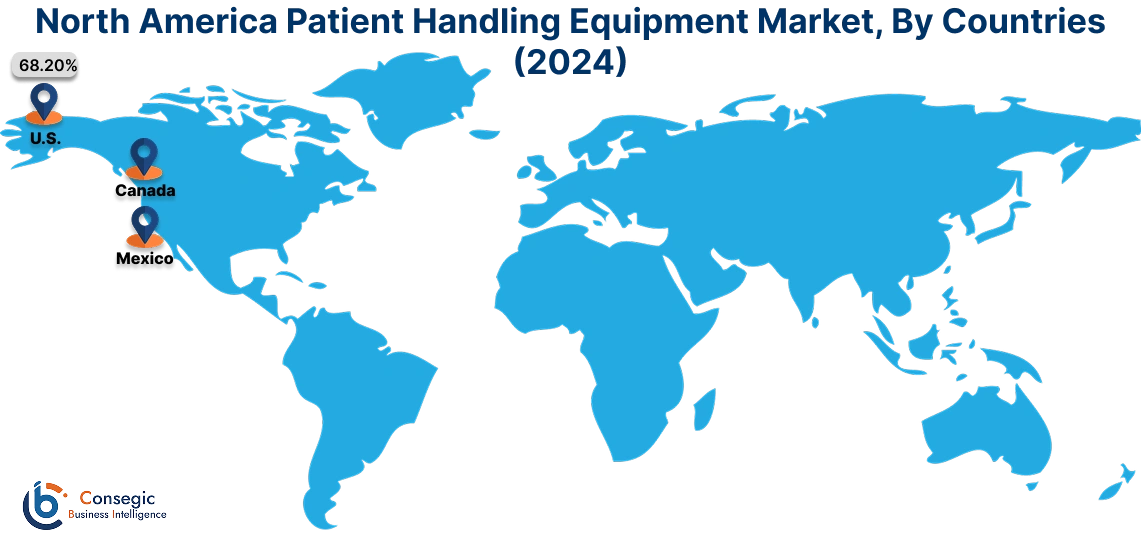
Asia Pacific is expected to grow at the fastest CAGR of 6.5% over the forecast period. The region is a rapidly growing market, driven by factors such as increasing population, developing healthcare infrastructure, and growing awareness of patient safety and staff well-being. Countries like China, India, Japan, and South Korea are major contributors to this growth. Moreover, the increasing prevalence of chronic diseases has led to a surge in the requirement for patient-handling equipment to assist with patient transfers, positioning, and mobility. Additionally, governments in the region are implementing regulations and guidelines to promote safe patient handling practices, further fueling the patient handling equipment market.
Europe holds a significant share in the global patient handling equipment market growth, characterized by the stringent regulations on patient handling practices, and technological advancements in these devices also contribute to the market trajectory across the region. The healthcare facilities in Europe are expanding rapidly, thus increasing the adoption of advanced equipment to improve patient care and reduce the risk of injuries to both patients and healthcare workers. In addition, the growing requirement for home care also creates the patient handling equipment market opportunities across the region.
The Middle East and Africa (MEA) region is witnessing notable patient handling equipment market demand. The healthcare sector in the Middle East is playing a pivotal role in the requirement for this equipment by the establishment of more hospitals, clinics, home care, and specialty centers. These sectors heavily rely on equipment for patient handling to improving the patient care and reduce the risk of injuries. As healthcare systems in the region continue to modernize, the adoption of innovative patient handling solutions is expected to accelerate.
As per the analysis of the patient handling equipment market, the Latin American market is growing substantially, driven by factors such as an aging population, increasing prevalence of chronic diseases, and growing healthcare infrastructure. Countries like Brazil and Argentina are expanding their healthcare sectors, contributing to their market growth. With emphasis on patient safety and reducing the risk of injuries due to the equipment among healthcare workers, there is a rise in need for advanced equipment for patient handling. As healthcare facilities in Latin America continue to develop and modernize, the need for advanced equipment for patient handling is expected to increase rapidly. Analysis shows that, developments for healthcare providers and manufacturers to provide innovative patient handling solutions in the region.
Top Key Players & Market Share Insights:
The Patient Handling Equipment market is highly competitive, with major players providing products to the national and international markets. Companies are adopting several strategies in research and development to hold a strong position in the global Patient Handling Equipment market. Key players include-
- Stryker (U.S.)
- Hillrom and Welch Allyn (U.S.)
- Getinge (Sweden)
- Baxter (U.S.)
- Joerns Healthcare (U.S.)
- GF Health Products, Inc. (U.S.)
- Etac AB (Sweden)
- Guldmann (Denmark)
- Invacare Corporation (U.S.)
- Arjo (Sweden)
Recent Industry Developments :
Product Launch:
- In April 2025, Arjo launched a new mobile patient floor lift known as Maxi Move 5, designed to improve patient care and reduce injuries to care providers. Its intuitive design reduces the load of manoeuvring and muscle effort. It is a key product in the company’s patient handling portfolio.
- In July 2024, Top Medical Mobility (TMM) launched a new line of Hoyer lifts and patient lift transfer chairs designed for home use. These hydraulic lift solutions aim to alleviate the physical strain on caregivers by providing hydraulic assistance for seamless patient transfers.
- In May 2024, Küschall, renowned for its pioneering designs and use of state-of-the-art materials, unveiled a new Champion SL manual wheelchair, the Küschall Champion SL. Super light and rigid, the Champion SL blends the convenience of the first folding rigid chair.
Patient Handling Equipment Market Report Insights :
| Report Attributes | Report Details |
| Study Timeline | 2019-2032 |
| Market Size in 2031 | USD 17,705.34 Million |
| CAGR (2024-2031) | 6.10% |
| By Equipment Type |
|
| By Application |
|
| By End-User |
|
| By Region |
|
| Key Players |
|
| North America | U.S. Canada Mexico |
| Europe | U.K. Germany France Spain Italy Russia Benelux Rest of Europe |
| APAC | China South Korea Japan India Australia ASEAN Rest of Asia-Pacific |
| Middle East and Africa | GCC Turkey South Africa Rest of MEA |
| LATAM | Brazil Argentina Chile Rest of LATAM |
| Report Coverage |
|
Key Questions Answered in the Report
How big is the patient handling equipment market? +
The Patient Handling Equipment Market size is estimated to reach over USD 17,705.34 Million by 2032 from a value of USD 11,396.79 Million in 2024 and is projected to grow by USD 11,843.73 Million in 2025, growing at a CAGR of 6.10% from 2025 to 2032.
Which region holds the largest market share for the patient handling equipment market? +
The North American region dominates the patient handling equipment market in 2024.
Which specific segments are covered in the segmental analysis of the patient handling equipment market? +
The patient handling equipment Market is specifically segmented By Equipment Type, By End User, By Application, and by region.
Who are the key players in the patient handling equipment market? +
The key players in the patient handling equipment Market are Stryker (U.S.), Hillrom and Welch Allyn (U.S.), GF Health Products, Inc. (U.S.), Etac AB (Sweden), Guldmann (Denmark), Invacare Corporation (U.S.), Arjo (Sweden), Getinge (Sweden), Baxter (U.S.), Joerns Healthcare (U.S.).
